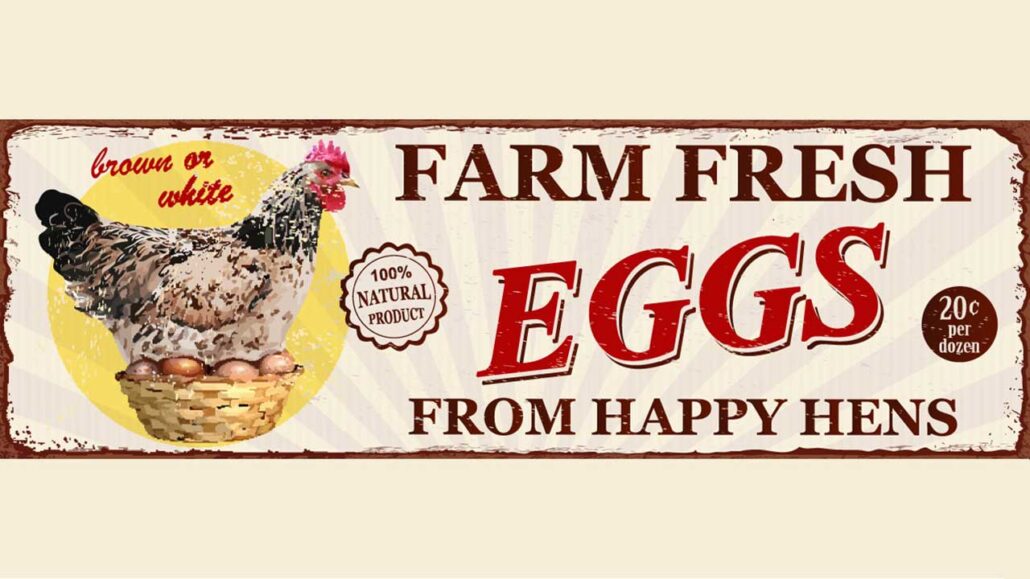Egg Labels Explained
The old commercial for “The Incredible Edible Egg” may bring fond memories of your childhood and the promise of a delicious and nutritious breakfast, but if it were on TV nowadays, it may also bring to mind the confusing labels we encounter while shopping for eggs. Plastered across cartons are claims such as “pasture raised,” “omega-3s,” “cage-free,” “natural” and more. What do these actually mean, which ones are regulated, and how do you ensure you are consuming eggs that are, in fact, incredible?!
For answers, we need to understand the lifestyle of chickens. Just like the quality of soil affects the nutrient content of produce, both the living conditions and the eating habits of egg-laying hens determine the nutritional composition of their eggs.
Let’s start with the ordinary, easily accessible eggs that are often the cheapest option at the grocery store. Labeled only with size and color and making no claims about raising and feeding practices, these standard eggs come from large commercial farms. The hens are mostly kept in small cages stacked upon each other (aka “battery cages”). They have clipped wings and clipped beaks and are usually fed a diet composed of corn, soybeans and bakery meal (which is a combination of ground up leftover bakery items such as chips, crackers, and cereals).
Now let’s see what the labels mean.
Cage-Free eggs are laid by hens that aren’t in cages, but most of the other standards of commercial chicken egg farming that are listed above are the same. These chickens may live without cages but are in close quarters with little or no sunlight, and they have clipped wings and beaks.
In order for their eggs to bear this label, the USDA requires that the hens can “Roam vertically and horizontally in indoor houses and have access to fresh food and water. Must allow hens to exhibit natural behaviors and include enrichments such as scratch areas, perches, and nests. Have access to litter, protection from predators and to move in a barn in a manner that promotes bird welfare” (1).
Some states, like California, now require that laying hens are cage free.
Free-Range eggs are produced by hens that have some access to the outdoors for at least a portion of their lives. It may be any amount of time or any amount of space. The USDA only requires “Continuous access to outdoors during their laying cycle” (1). Unfortunately, this often means just a few moments of sunlight in a small, enclosed space.
Certified Organic eggs are laid by hens who were given organic feed that does not contain chemicals or antibiotics (except to treat a disease). The facility (producer), and processors must also be certified organic.
Organic eggs often—but not always—come from hens that aren’t raised in cages and have access to the outdoors.
Vegetarian-fed hens are kept inside and fed an all-vegetarian diet with no animal by-products. It is important to note that chickens are naturally omnivores, accustomed to eating a wide variety of foods including vegetation, grasses, herbs, seeds, fruits, worms, insects, snails etc.
Kosher eggs are eggs that come from kosher fowl, in this case, chickens that are raised in a way that complies with specific dietary laws. They must also be checked for the presence of spots of blood, which are not kosher.
Omega-3 Fortified eggs come from chickens fed a diet rich in omega-3 fats (see the eSavvyHealth Insight, The Fatty Acid Motel. This usually includes flaxseeds, which are added into their feed or made available for their consumption. Nutritionally, these eggs do have a higher omega-3 content. In fact, according to the USDA National Nutrient Database for Standard Reference, a conventional large egg has 51 mgs of omega-3s, while a fortified egg has 160-225 mgs (2).
Certified Humane eggs are laid by hens who must live in decent conditions that are checked regularly for rodents and have proper ventilation and appropriate floor coverings. They are also given boxes of dust and dry dirt to “bathe” in. Dust bathing is an innate behavior that allows chickens and other birds to remove excess oils and keep their feathers free from unwanted pests like parasites.
Local or locally produced eggs must originate from a source flock located less than 400 miles from the processing facility, or within the state in which the eggs originated and were processed. This designation is really about location and not about living or feeding conditions, but, if you have access to locally sourced, free range and certified humane eggs you are in luck!
The above labels all have meaning because they are regulated by the USDA. Those below do not, because they aren’t.
Farm-Fresh eggs are exactly as fresh as all eggs, considering the word simply implies the food is in its raw state, and has not been frozen or subjected to any form of thermal processing or preservation.
Natural eggs, like all eggs, are free from artificial coloring or ingredients.
Eggs with No Added Hormones are just eggs. Since the FDA prohibits the use of hormones in all chickens and eggs, all eggs are hormone free.
Humanely Raised eggs may or may not be humanely raised. Unless the carton has the “certified humane” label, there’s no telling if these truly meet humane raising conditions.
Fertile eggs are nutritionally no different from non-fertile eggs. The hens have mated with roosters, but the refrigeration inhibits the development of a chick.
Antibiotic-free eggs aren’t special. Because antibiotics tend to decrease egg production, most eggs in the U.S. fit into this category.
Pasture-Raised eggs might have been laid by chickens who were raised in a pasture, and might not, because this label is not regulated by the government. So, the consumer—that’s you!—would have to do research to determine what the farm practices are.
And by the way, the color of an egg means nothing in terms of nutrition. Hens produce a range of egg colors, from white to blue, light-green, brown and even pink!
What you should know: When chickens are humanely raised without cages, given access to fresh air, and allowed to eat grass, vegetation, kitchen scraps, insects and wholesome feed, they produce incredible eggs. That’s often the case with locally sourced eggs, but if your source is a grocery store, look for Omega-3, Organic, and Free-Range eggs as the factors most likely to affect nutritional value, and Certified Humane eggs If ethical practices are also important for you.
References:
- https://www.ams.usda.gov/sites/default/files/media/ShellEggLabelingUSDAGrademarkedProduct.pdf
- https://foodandnutrition.org/blogs/stone-soup/type-eggs-buy/
- https://sfyl.ifas.ufl.edu/archive/hot_topics/families_and_consumers/purchasing_eggs.shtml
- https://www.saudereggs.com/blog/your-complete-egg-buying-guide/
- https://www.aspca.org/shopwithyourheart/consumer-resources/meat-eggs-and-dairy-label-guide/understanding-egg-labels
- https://www.humanesociety.org/resources/how-decipher-egg-carton-labels
- https://www.poultryworld.net/the-industrymarkets/market-trends-analysis-the-industrymarkets-2/implementation-has-started-of-proposition-12-in-california/





